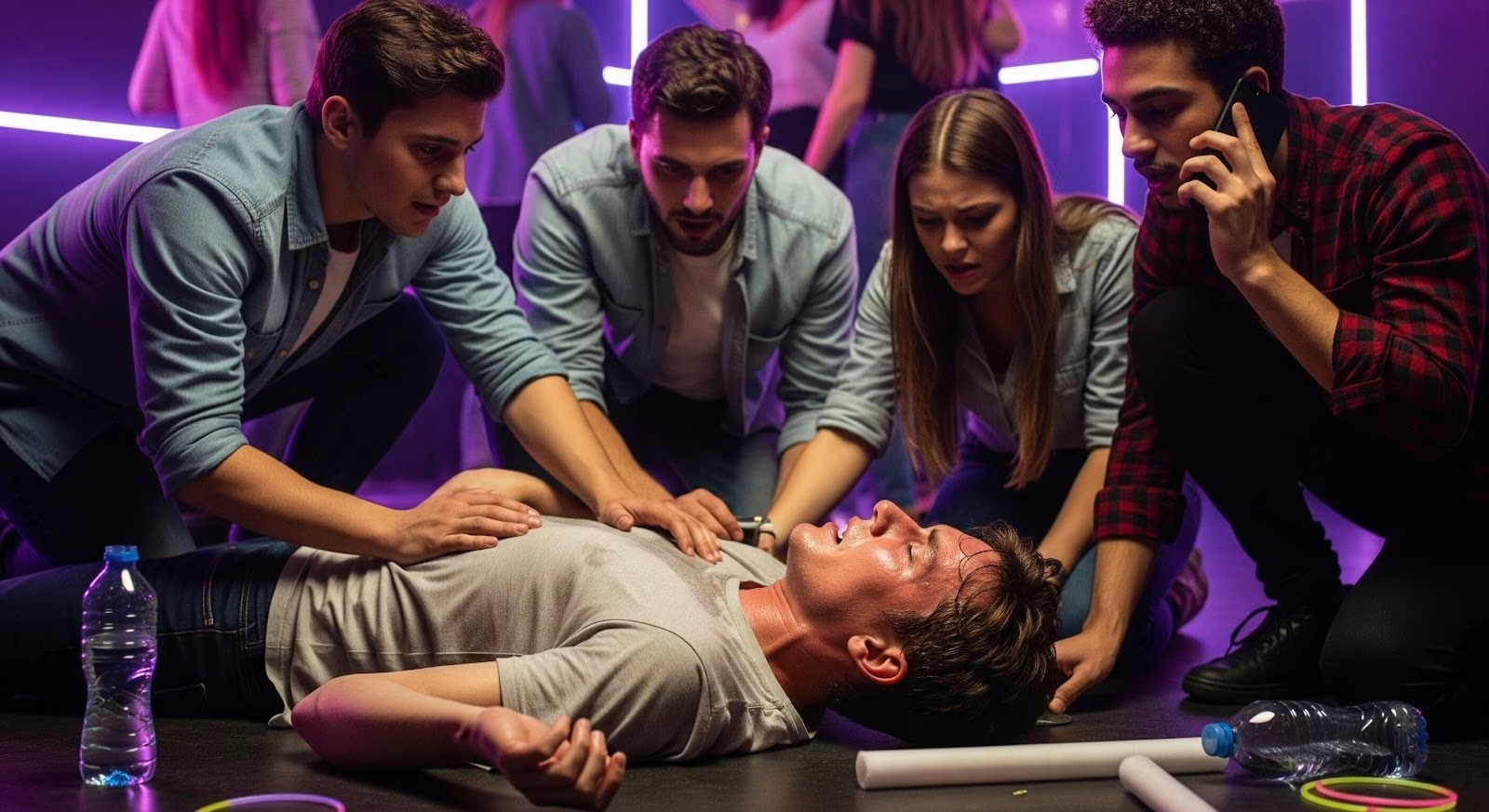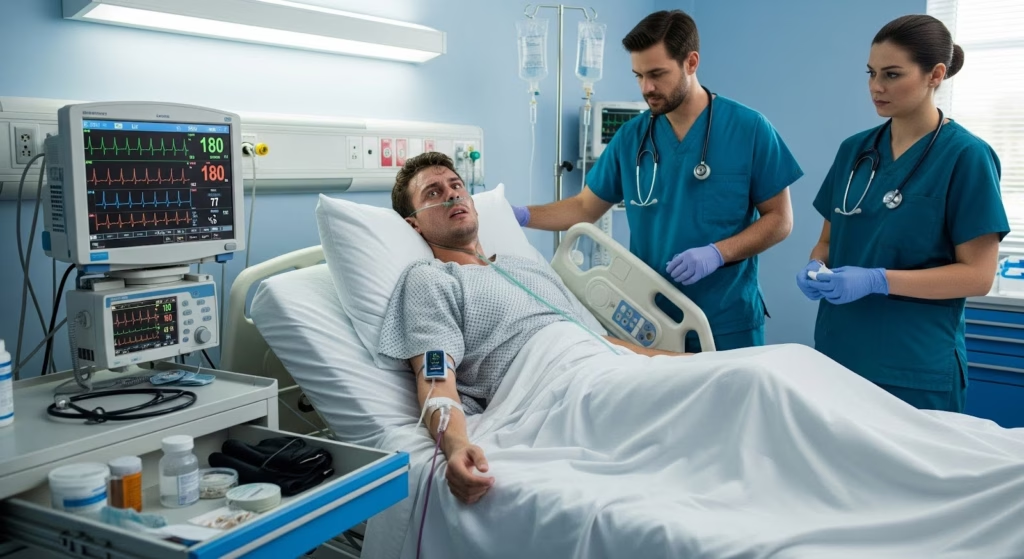
MDMA, commonly called molly or ecstasy, can absolutely cause a fatal overdose.
Yes, you can overdose on MDMA, and the most dangerous pathways are extreme hyperthermia and acute hyponatremia, often triggered by hot venues, physical exertion, and misguided hydration in nightlife settings where high dose tablets now circulate widely.
This article explains what an MDMA overdose looks like, how it happens, and what steps can save a life when every minute counts.
What is an MDMA Overdose?
An MDMA overdose is not just taking too many pills. It is a physiologic crisis where the body loses control of core functions, leading to organ failure and death. The clearest sign is runaway hyperthermia, when core temperature soars past 40°C and the body cannot cool itself.
The second lethal pathway is acute hyponatremia, when users drink too much water and dilute blood sodium to dangerous levels, causing brain swelling and seizures.
Unlike opioid overdoses that shut down breathing, MDMA overdose drives the body into overdrive. Heart rate and blood pressure spike. Muscles become rigid. Sweating may be profuse or stop entirely.
Confusion turns to delirium, then seizures or coma. Kidneys fail as muscle tissue breaks down. Blood clotting goes haywire. Liver enzymes climb.
These are not subtle symptoms. When someone collapses at a rave or festival after taking molly, the emergency is already underway. The difference between survival and death often comes down to how fast bystanders recognize the red flags and get medical help.
How MDMA Overdose Happens?
MDMA floods the brain with serotonin and raises levels of norepinephrine and dopamine. This surge produces the euphoria and connection users seek, but it also pushes the cardiovascular and thermoregulatory systems to their limits.
At moderate doses in cool, calm settings, most people tolerate MDMA without life threatening complications. The danger escalates when dose, environment, and behavior converge.
European drug monitoring in 2024 found that more than half of tested tablets at one major festival exceeded 200 mg of MDMA. Some pills reaching 300 mg have reappeared after years. Users who redose because they think the first pill was weak can stack dangerous amounts in their system within hours.
The setting amplifies risk. Hot, crowded indoor venues trap heat. Vigorous dancing for hours generates more body heat. MDMA itself impairs the body’s ability to dissipate heat by constricting blood vessels in the skin.
The result is a thermal runaway that can push core temperature into lethal territory in less than an hour.
Polydrug use adds another layer of danger. Alcohol increases dehydration. Stimulants like cocaine or methamphetamine compound cardiovascular strain.
Mixing MDMA with serotonergic medications, especially MAOIs but also SSRIs, SNRIs, tramadol, or certain migraine drugs, can trigger serotonin toxicity marked by muscle rigidity, fever, and rapid deterioration.
Market unpredictability matters too. Although adulteration with synthetic cathinones dropped to under 2% of samples in European drug checking networks by 2024, potency varies wildly. Pill logos and colors are unreliable guides to strength.
A user who took one pill last month and felt fine may take what looks like the same pill this month and end up in the emergency department.

Signs You’re Having an MDMA Overdose
Recognizing an MDMA overdose early can be lifesaving. The warning signs fall into several clusters, and any one of them warrants immediate medical attention.
Hyperthermia signs:
- Feeling uncomfortably hot even after leaving the dance floor
- Confusion or disorientation
- Severe agitation or combativeness
- Profuse sweating or, paradoxically, hot dry skin
- Muscle spasms, tremors, or rigidity
- Rapid heart rate and breathing
Hyponatremia signs:
- Severe headache
- Nausea and vomiting
- Bloating or feeling waterlogged
- Confusion or slurred speech
- Seizures
- Loss of consciousness
Cardiovascular signs:
- Chest pain
- Irregular heartbeat
- Very high blood pressure
- Difficulty breathing
Neurologic signs:
- Uncontrollable shaking or twitching
- Seizures
- Inability to stay awake or respond
- Coma
The tricky part is that early symptoms, such as mild nausea or a headache, can be mistaken for a normal comedown or just feeling tired. That is why medical guidelines stress seeking help at the first sign of something wrong.
Public health authorities in Australia have documented clusters of overdoses where multiple people needed hospital care after using MDMA at a single event, underscoring how environmental factors turn manageable doses into medical emergencies.
The table below shows the two main overdose pathways and their key features.
| Overdose Pathway | Primary Trigger | Key Signs | Critical Intervention |
| Hyperthermia | Hot venue, exertion, high dose | Core temp over 40°C, confusion, agitation, muscle rigidity | Ice water immersion, sedation, emergency transport |
| Hyponatremia | Overdrinking water, MDMA induced SIADH | Headache, vomiting, seizures, normal or mildly elevated temp | 3% hypertonic saline, avoid free water, emergency transport |
The Role of Heat and Environment
Heat is the single most important environmental factor that transforms MDMA from a recreational drug into a killer. Animal studies and mechanistic research confirm that ambient temperature directly raises MDMA lethality. Crowded dance floors where hundreds of bodies radiate heat, combined with poor ventilation and continuous exertion, create a perfect storm.
MDMA causes peripheral vasoconstriction, which means blood vessels in the skin tighten. This reduces the body’s ability to release heat through the skin.
At the same time, the drug increases metabolic rate and muscle activity, generating more internal heat. When you add vigorous dancing in a hot room, the body cannot keep up. Core temperature climbs. Once it crosses 40°C, proteins start to denature, cells malfunction, and organs begin to fail.
The cascade happens fast. Hyperthermia damages the liver, kidneys, heart, and brain. Muscle fibers break down, releasing myoglobin into the bloodstream, which clogs kidney filters and causes acute kidney injury.
Blood clotting mechanisms fail, leading to disseminated intravascular coagulation. Enzymes that normally regulate metabolism stop working. The person may become delirious, combative, or unconscious.
Cooling breaks matter. Venues with air conditioning, shaded rest areas, misting stations, and accessible water can reduce risk. But cooling alone is not enough if someone is already in crisis.
Emergency responders must measure rectal temperature, the only reliable method in the field, and begin aggressive cooling with ice water immersion or cold packs to the groin, armpits, and neck. Benzodiazepines help by reducing agitation and muscle activity, which lowers heat production.

Hyponatremia: The Water Danger
The advice to “drink water” at raves has saved some people from dehydration, but it has killed others. MDMA stimulates the release of antidiuretic hormone, which tells the kidneys to hold onto water.
When someone drinks large amounts of free water, especially without electrolytes, blood sodium drops. This dilutional hyponatremia causes water to shift into brain cells, leading to cerebral edema.
Early symptoms include headache, nausea, and bloating. As sodium falls further, confusion and disorientation set in. Seizures can follow. In severe cases, brain herniation and death occur. Women appear to be at higher risk for severe hyponatremia, possibly due to hormonal and body composition factors.
The most dangerous mistake is assuming that someone who is confused and vomiting after taking MDMA is simply dehydrated and giving them more water or hypotonic IV fluids.
This worsens cerebral edema. Wilderness medicine guidelines stress that suspected hyponatremia should be treated with 100 mL boluses of 3% hypertonic saline, repeated up to three times, while arranging emergency transport.
The best prevention is balanced hydration. If you are dancing and sweating, aim for about 500 mL per hour. If you are resting or in a cooler area, 250 mL per hour is enough. Drink when you are thirsty, not on a rigid schedule. Choose drinks with electrolytes over plain water when possible. Avoid chugging large volumes at once.
What to Do in an Emergency?
If someone shows any signs of MDMA overdose, call an ambulance immediately. Do not wait to see if symptoms improve. Minutes matter.
While waiting for emergency services:
- Move the person to a cool, quiet area away from crowds and noise.
- Remove excess clothing and use fans, cold packs, or wet towels to start cooling.
- If the person is conscious and able to swallow, offer small sips of water or an electrolyte drink, but do not force fluids.
- Stay with them and monitor breathing and responsiveness.
- If they have a seizure, protect their head, turn them on their side, and do not put anything in their mouth.
- Be ready to tell paramedics what substances were taken, when, and how much, along with any other drugs or medications the person uses.
Do not try to restrain someone who is agitated. Physical restraint increases muscle activity, which raises body temperature and worsens rhabdomyolysis. If the person is combative, keep others at a safe distance and let trained responders handle sedation.
Paramedics and emergency department staff will measure core temperature, check electrolytes including sodium, and assess kidney and liver function.
Treatment priorities include rapid cooling for hyperthermia, benzodiazepines for agitation, IV fluids tailored to electrolyte status, and management of complications like rhabdomyolysis and coagulopathy. In cases of confirmed hyponatremia, hypertonic saline is given cautiously to avoid overcorrection, which can cause its own neurologic damage.
For suspected serotonin toxicity, especially when MDMA was combined with other serotonergic drugs, the focus remains on supportive care. Stopping all serotonergic agents, sedation, and aggressive cooling are the mainstays. Cyproheptadine is sometimes used, but evidence is limited, and it should never delay definitive treatment.
Why Does It Matter?
MDMA overdose is preventable. The pathways to harm are well understood, and the interventions that save lives are straightforward. Yet people continue to die because of three gaps: knowledge, environment, and access to care.
Many users do not know that logos and colors tell them nothing about pill strength. They do not realize that redosing is far riskier than taking a single dose. They have heard “drink water,” but not “drink to thirst” or the warning about hyponatremia. They underestimate how much heat and exertion matter.
Festival and venue organizers can close the environment gap by ensuring adequate cooling, rest areas, free water and electrolyte options, and on site medical teams trained to recognize and manage MDMA toxicity.
Drug checking services, where legal, give users real information about what they are taking and reduce the risk of unexpected high doses or adulterants.
Access to care is often delayed by fear. People worry that calling an ambulance will bring police or legal consequences. That fear costs lives. In many places, Good Samaritan laws protect people who seek help during an overdose. Paramedics and emergency doctors are focused on saving lives, not making arrests.
Understanding the difference between feeling anxious or uncomfortable and having a medical emergency is critical. A bad trip is mostly psychological distress, often with mild increases in heart rate and blood pressure but no objective signs of organ failure.
An overdose involves objective instability: spiking temperature, seizures, loss of consciousness, or lab values showing kidney failure and electrolyte chaos. When in doubt, get help.
Getting Help After an Overdose
Surviving an MDMA overdose is only the first step. The experience often reveals an underlying pattern of substance use that needs attention. If you or someone you care about has had a close call with molly, it may be time to consider Thoroughbred’s comprehensive support.
Thoroughbred Wellness and Recovery’s professional medical detox and integrated treatment can address both the physical risks of continued use and the psychological factors that drive it, offering a path toward lasting recovery and safety.









